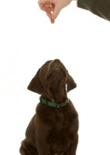The Fundamentals of How To Train a Labrador Retriever
By Sally Gutteridge | Breeds

 The Labrador retriever is a simple dog. He asks very few questions and has much love to share around. He doesn’t have the high and often complicated intelligence of other working dog breeds. If, however, any dog breed had the capability for emotional intelligence the Labrador would be it.
The Labrador retriever is a simple dog. He asks very few questions and has much love to share around. He doesn’t have the high and often complicated intelligence of other working dog breeds. If, however, any dog breed had the capability for emotional intelligence the Labrador would be it.
The Labrador is a gun dog who was originally bred to retrieve injured or dead birds after they have been shot. His specific employment is to carry the quarry in his soft mouth and often walk through wet and rugged conditions. The Labrador is still used regularly in this circumstance as well as being a popular and common family pet.
Trainability of your Labrador
This breed of dog is extremely trainable and with his loyalty and consistency is perfectly suited to a working life providing assistance to disabled people. The Labrador is trained as a guide, hearing and disability assistance dog in many countries. This breed of dog is also employed to work with police and in military circumstances to search for weapons, explosives, drugs and many other things. In fact any professional dog trainer in any field will be able to help you with how to train a Labrador.
Food and Weight
The dog’s behavior around food will need to be monitored. Most Labradors are often continuously hungry. Weight gain is probable if food intake is not monitored and this can put strain on joints and organs. This breed can have a tendency to believe that he must eat until bursting point. Luckily he will usually accept any type of food therefore carrot pieces or cherry tomatoes can be useful training treats. If this is not working it is worth taking training reward directly from your Labradors daily food allowance.
Fear barking, how to train a Labrador to focus
The Labrador, particularly the female of the breed can develop spooking behavior. This will consist of growling or barking at a stimulus. Based in fear the spooking behavior is simply an instant reaction to a sudden and unexpected visual stimulus. It takes the form of instant surprise followed by a noisy defense. If spook barking is not handled correctly, the behavior can become complicated by the dog moving forward to the stimulus. Still based in fear this can be a dangerous habit to develop.
Prevention of the behavior is paramount. By distracting your dog from anything that may cause a reaction, you will take away the element of surprise. When on walks with your dog, encourage him to look at you regularly. When he does, then reward and reinforce with a treat. Practice keeping his attention on you for as long as possible by using multiple treats and gradually withholding the reward. You can then utilize this by identifying possible trigger experiences before the dog does and keeping her attention on you until the trigger has passed.
How to train a Labrador to greet in a social manner
One of the main things to look out for when you are researching how to train a Labrador retriever is general manners. Your Labrador will jump up at everyone possible, if not trained otherwise. If you are seeking how to train a Labrador from puppyhood the most important thing to remember is that one day this cute puppy will grow up. The Labrador loves human contact and can easily grow into a bouncy and hazardous adult dog.
Because it is tempting and easy to lean down and praise a puppy that is small and cute, the dog as a youngster often learns that jumping up brings reward. By the time he begins to grow, this behavior is established and the owner does not know how to deal with his behavior. Eventually the dog becomes a 65lbs (30kg) lump that is persistent in his jumping up because it always worked for him before.
Luckily, how to train a Labrador to keep all four paws on the ground is easy with minimal research. You need to teach him an alternative behavior. With food reward and positive reinforcement this should be easy. Sit on greeting is a great alternative to jumping up. There are many options to use when working out how to train a Labrador to sit. Clicker training is a great reinforcement technique, particularly for the Labrador and his insatiable hunger.
When it is confirmed in his mind that sit brings food reward your Labrador will offer it whenever he senses food in the general vicinity. You will then need to add a command word. “Sit” is the obvious one. When your Labrador greets you then utilize the word sit and your treats before he jumps up. Timed properly this will work. If your dog jumps up or tries to grab for the treats simply turn away and hold the food above your head. He will soon learn that it is more rewarding to greet you nicely than with the extra gusto of previous occasions.
Session expired
Please log in again. The login page will open in a new tab. After logging in you can close it and return to this page.
nice tips
i need help training my dog Diamond to stop jumping and chewing even with 19 toy to play with it was 20 but he had tour up the other one.
LOOKING FORWARD TO IT….WE TOOK OUR MALE LAB ON BOARD ONLY A MONTH AGO , ITS 11 MONTHS ON AND WE HAVE SOME WORK TO DO….WE LOVE HIM HEAPS AND WE WILL DO WHATEVER IT TAKES TO TRAIN HIM PROFFESSIONAL … 🙂 THE AREA WERE WE LIVE IS MADE FOR THEM….LOTS OF WATER ,RIVERS and birds.